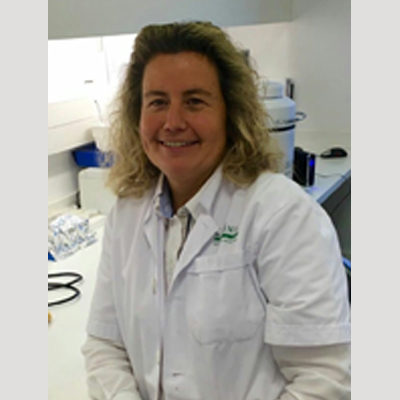| This month’s interview comes from Barcelona, Spain. I had the pleasure to meet Olga Millán at last year’s congress, where she was among the early risers for the morning jog (not me, I was an admirer of the photos). Exhibiting similar speed, Olga has been the fastest responder to our interviews (less than 24h), greatly appreciated in a time of end of year commitments and pre-festivities. Olga shares about her long-term experience with a clinical lab and research group dedicated to discovery and implementation of biomarkers for tailoring immunosuppressant treatment.
Olga Millán
Researcher, Networked Biomedical Research Center (CIBERehd)
Pharmacology and Toxicology Laboratory (CDB)
Hospital Clinic, Barcelona, SP
|
Can you tell us a little bit about your respective roles? What is a typical day like for you?
I am a researcher at CIBERehd (Networked Biomedical Research Center: Hepatic Immunology, Cellular Therapy and Transplants) and I work at the Pharmacology and Toxicology Laboratory of the Biologic Diagnostic Center, Hospital Clinic of Barcelona. I started working here in 2003 in Dr. Mercè Brunet’s team. I previously worked in the Immunology laboratory of the same Hospital since 1995.
My research activity is mainly focused on identification and validation of panels of biomarkers for the diagnosis and prognosis of rejection risk, graft outcome, and personal response to immunosuppressive treatment in solid organ transplant recipients. Further, I work in Dr. Mercè Brunet’s team on developing new monitoring approaches combining pharmacodynamic parameters, pharmacogenetics and pharmacokinetics for personalized therapy, as well as the standardization of biomarker evaluation methods.
A typical week for me: three days I focus on the analysis of biomarkers from renal and liver transplant patients involved in our projects, and the standardization of new methods. If I’m not on lab duty, I prepare projects for the lab, write articles, project reports, data analysis, etc. together with Dr. Brunet.
Is there anything that your laboratory does, or that is done at your hospital/centre, that you would consider innovative?
Dr. Mercè Brunet is particularly innovative in developing new methods, especially by mass spectrometry for TDM using new approaches and alternative matrices, such as Dried Blood Spots and intracellular drug measurements that better correlate with pharmacodynamic biomarkers and clinical outcome. Also, she is interested in the development of new PK-PD Models.
What technological innovations have entered into use during your career that have permitted a change, or evolution, in practice?
For pharmacodynamic monitoring, the use of flow cytometry as it is a highly versatile method that simultaneously provides information about the phenotypic and functional characteristics of cells and enables quantification of large numbers of cells and assessment of their subset distribution, activation status, cytokine production profile, and other cellular functions. This technique plays an important role in the prioritization, verification and clinical validation of new biomarkers (See our Chapter Flow Cytometry as Platform for Biomarker Discovery and Clinical Validation in General Methods in Biomarker Research and their Applications, Preedy and Patel (Eds), Springer, 2015)
How did you become interested in your area of expertise?
My thesis project focused on the pharmacodynamic monitoring of immunosuppressive therapy. When I finished it, I was asked to continue working at Dr. Brunet’s lab and through her I started to participate in the IATDMCT.
Is there anything that you’ve seen or heard about recently and thought “I’d like to incorporate that idea at my center”?
I would be interested to test and standardize at our lab the method developed by Dr. Claudia Sommerer for the evaluation of residual gene expression of NFAT to evaluate response to calcineurin inhibitors.
What sort of research do you have on the horizon that you think might influence clinical practice in the future?
In my field of interest, early identification of transplant recipients at high risk for immunologic complications has been a priority in transplantation research. Our experience, that spans more than 15 years in the field of non-invasive biomarkers for the diagnosis and prognosis of rejection risk, clinical outcome, and drug response, supports further multicenter work to clinically evaluate biomarker panels as tools for therapeutic management, and their standardization, feasibility and cost effectiveness for clinical implementation.
We have published several manuscripts describing the utility to monitor intracellular IFN-g and IL-2 expression in T-lymphocytes by flow cytometry, during the pre-transplant and early post-transplant period, as prognostic and diagnostic biomarkers for acute rejection risk in liver and renal transplant recipients. In our experience, analysis of %CD8+IL-2, %CD4+IFN-γ and %CD8+IFN-γ may predict rejection risk that can be combined with other biomarkers and drug exposure to achieve the most appropriate degree of immunosuppression in each treated patient.
What do you consider is the future for TDM and CT? What are you excited about? What are the challenges we face?
In my opinion, a combination of pharmacokinetic and pharmacodynamic monitoring, based on specific biomarkers is required to individually tailor drug doses and select the best treatment for each patient. In my particular field of research on biomarkers, monitoring using a panel of valid biomarkers may permit patient stratification, and improve pharmacology treatment. Cut-off values need to be defined and validated in independent populations and between laboratories in multicenter, randomized controlled clinical trials, collaborations that could be fostered by participating in international professional organizations such as the IATDMCT. Further research in the field of biomarkers should be continued.
The content of the IATDMCT Blog does not necessarily have the endorsement of the Association.



